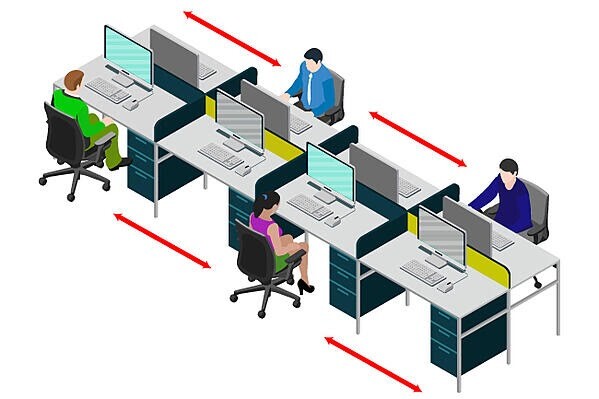It’s been nearly a year since the COVID-19 lockdown began, and there is still no clear end in sight. That doesn’t mean we can’t plan for safe office social distancing.
So, let’s talk about what we can do to get started.
While many of us now work from home, there are still plenty of offices that remain open, so following social distancing protocols is paramount to staying safe and healthy.
There are the basic, common-sense rules, such as:
- Promoting personal hygiene.
- Ensuring physical distance.
- Avoiding handshakes.
- Getting your own coffee.
1. Use Social Distancing Signs
One of the first things businesses can do to implement office social distancing is to set up social distancing signs. This tip is relatively cost effective and simple to do, there are many local businesses who can print these signs for you. If a printing shop is not available, you can print your own and use some tape! The hardest part may be the planning factor before you stick your signs on the wall or the ground.
These signs can be displayed on floors, sidewalks, storefronts, and windows to indicate one-way aisles and to remind customers to keep their distance. It has also been used for employees to remind them to keep their distance from others while they are working. These signs keep people safe and ensure they can work productively without feeling intimidated.
Floor signage and other social distancing signs are a simple way to help give people direction and to create a simple flow that adheres to social distancing rules that people can easily adjust to. They also serve as a visual reminder of how much space to leave for people so that everyone can remain safe.
Many employees will feel safer while continuing their work during this time and feel protected by their employer. This is a great way to continue to boost your employee morale at this time.
2. Rethink The Way You Schedule Shifts
Consider implementing flexible work hours or rotational shifts to limit the number of employees in the workplace at the same time. Use the time between shifts to properly clean and disinfect your workstations.
The Centers for Disease Control and Prevention also suggests you:
- Develop other flexible policies for scheduling.
- Telework (if feasible).
- Create leave policies to allow employees to stay at home to care for sick members or care for children if schools and childcare close.
For example, people in Group A are only scheduled to work with Group A. People in Group B are only scheduled to work with people in Group B.
A schedule may look like this:
- Weekday, Morning Shift → Monday – Friday: Group A
- Weekday, Afternoon Shift → Monday – Friday: Group B
- Weekend, Morning Shift → Saturday – Sunday: Group C
- Weekend, Afternoon Shift → Saturday – Sunday: Group D
3. Redesigned Workspaces
This option requires more effort but is possibly the most important aspect to consider. Many office spaces are tight and crowded, leaving employees at great risk of infection. To alleviate this, you can adjust the workspaces to accommodate the new protocols. Where possible, you want to create social distancing partitions and barriers between employees. You may have seen this done in your local grocery store or your favourite fast food restaurant.
In an office setting, in addition to spacing workspaces, you can add physical barriers between people. You can achieve this by raising cubicle walls or adding plexiglass dividers between workspaces, as well as in the break room or other common areas where people sit together.
In manufacturing, warehouse facilities, and other open-space workplace settings, you can use bright, bold-coloured graphic stripes to mark pathways and indicate where people may stand while maintaining a safe distance from one another. This can be done by using our first tip and adding social distancing signage.
Rethink how people move through the office or workspace, you can do this by making hallways and stairwells one-way only and put up signs to make it clear.
Think of road markings but for the office. With room dividers, you can create flexible routing in the areas where people are most likely to come into contact with each other.
Portable storage containers can be a perfect solution for storing extra office furniture, tools, and supplies! This can make the transition of your redesigned work areas much easier and can keep your equipment onsite for easy and convenient access.
4. Inform Your Customers
Now more than ever, communicating with your customers is critically important.
Letting them know you’re open for business and informing them of the measures you are taking to safely open back up or stay open is important to every customer who is seeking your business.
There are plenty of quick, cost-effective ways to do this, such as:
- Updating your website.
- Updating your Google My Business page.
- Updating your social media channels.
- Sending emails.
- Placing temporary signs and banners inside and outside your business.
5. Keep It Clean / Wear a Mask
This kind of falls back into those common-sense actions we can take to help prevent infection and to keep ourselves and those around us safe and healthy.
This includes:
- Cleaning and disinfecting high-touch surfaces (e.g., doorknobs, light switches, toilet handles, sink faucets, work stations, cash registers, shopping carts).
- Ensuring there is enough soap, paper towels, disinfecting wipes and hand sanitizer available.
- Provide face masks for your employees and even for your customers before they walk in the door.
It’s true that keyboards and laptops are dirty, but it’s mostly your own bacteria. However, this is not the case with hot-desking (or hotel seating).
Therefore, it’s better to assign every employee to a fixed workstation. Only practice hot-desking if you can make sure that the tabletops and office equipment are sanitized regularly.
Also, you can consider switching to desks with special anti-bacterial tabletops.
That’s A Wrap
After months of self-isolation, people might be eager to get back to the office. However, practicing social distancing is crucial to our health and safety. We know how important maintaining your business is right now while keeping your employees and customers safe, which is why we’re offering this handy guide for free!
We all know the rules by now. Stay at home if you cough, have a fever or shortness of breath. Sneeze or cough in your elbow and don’t touch your face. While these are general COVID-19 rules, there is also a need for the new office etiquette.
Some people might be fearful of returning to work. The choice should be up to them, so be aware of peer pressure from colleagues.
Everybody has a different background and approach to dealing with this crisis.
As we’ve seen in the past months, working from home in teams is also working out for most office jobs. So striking a balance between working from the office and home might be the perfect solution to slowly be getting back to a new normal.
We’re in this together, so let’s help each other out in whatever ways we can!


